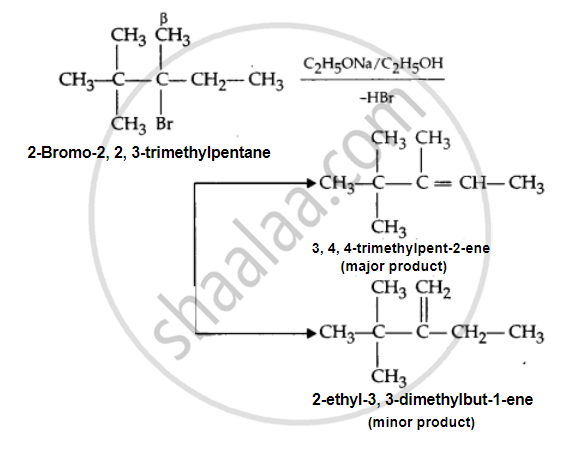Advertisements
Advertisements
प्रश्न
Predict all the alkenes that would be formed by dehydrohalogenation of the following halide with sodium ethoxide in ethanol and identify the major alkene:
2, 2, 3-Trimethyl-3-bromopentane
उत्तर
There are two different types of β-hydrogen atoms present in the halide. Hence, in the dehydrohalogenation reaction, it will form two alkenes: 3, 4, 4-trimethylpent-2-ene and 2-ethyl-3, 3-dimethylbut-1-ene. The first alkene is more stable because it is more substituted (according to Saytzeff rule). Hence, it is the major product.

APPEARS IN
संबंधित प्रश्न
Identify the product ‘D’ in the following sequence of reactions:
\[\ce{H3C - CH2 - CH2 - Cl \underset{KOH}{\overset{Alc}{->}} 'B' \overset{HBr}{->} 'C' \underset{Elther}{\overset{Na}{->}}'D'}\]
State and explain Markownikoff's rule with suitable example
How do you convert: 2-bromobutane to but-2-ene
Write the main products when n-butyl chloride is treated with alcoholic KOH.
Predict all the alkenes that would be formed by dehydrohalogenation of the following halide with sodium ethoxide in ethanol and identify the major alkene:
1-Bromo-1-methylcyclohexane
How will you bring about the following conversion?
But-1-ene to but-2-ene
Write the structure of the major organic product in the following reaction:
\[\ce{(CH3)3CBr + KOH ->[ethanol][heat]}\]
Draw a neat, labelled energy profile diagram for SN1 reaction mechanism.
What are racemates?
Observe the following compounds and answer the questions given below.

(I)
\[\ce{\underset{\text{(II)}}{CH3 - CH2 - Br}}\]
- Identify the type of halides.
- Explain the nature of the C – Br bond in both of these halides.
- Which of these compounds will undergo aqueous alkaline hydrolysis readily? Write the reaction in support of your answer.

'A' is:
Elimination of bromine from 2-bromobutane results in the formation of ______.
Name the following halides according to IUPAC system and classify them as alkyl, allyl, benzyl (primary, secondary, tertiary), vinyl or aryl halides:
\[\ce{CH3 C(CI) (C2H5)CH2CH3 }\]
